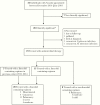Safety and Outcomes of Linezolid Use for Nocardiosis
- PMID: 32258209
- PMCID: PMC7112726
- DOI: 10.1093/ofid/ofaa090
Safety and Outcomes of Linezolid Use for Nocardiosis
Abstract
Background: Tropical Australia has a high incidence of nocardiosis, with high rates of intrinsic antimicrobial resistance. Linezolid, the only antimicrobial to which all local Nocardia species are susceptible, has been recommended in empirical combination treatment regimens for moderate-severe Nocardia infections at Royal Darwin Hospital (RDH) since 2014. We report the safety and efficacy of linezolid use for nocardiosis in this setting.
Methods: We identified cases through a retrospective review of all RDH Nocardia isolates from December 2014 to August 2018 and included 5 linezolid-treated cases from a previous cohort. Laboratory, demographic, and clinical data were included in the primary analysis of safety and treatment outcomes.
Results: Between 2014 and 2018, Nocardia was isolated from 35 individuals; 28 (80%) had clinically significant infection and 23 (82%) received treatment. All isolates were linezolid-susceptible. Safety and efficacy were assessed for 20 patients receiving linezolid-containing regimens and 8 receiving nonlinezolid regimens. Median linezolid induction therapy duration was 28 days. Common adverse effects in those receiving linezolid were thrombocytopenia (45%) and anemia (40%). Adverse events prompted discontinuation of trimethoprim-sulfamethoxazole more often than linezolid (40% vs 20%). Linezolid therapeutic drug monitoring was used in 1 patient, with successful dose reduction and outcome. There was no difference in 30-day survival between those treated with linezolid (90%) vs no linezolid (87%). One Nocardia-attributed death occurred during linezolid therapy.
Conclusions: Linezolid is safe and efficacious in empirical treatment for moderate to severe nocardiosis in a monitored hospital setting, with 100% drug susceptibility and no difference in adverse events or outcomes compared with nonlinezolid regimens.
Keywords: Nocardia; antimicrobial resistance; linezolid; prophylaxis; therapy.
© The Author(s) 2020. Published by Oxford University Press on behalf of Infectious Diseases Society of America.
Figures



Similar articles
-
Nocardiosis at the turn of the century.Medicine (Baltimore). 2009 Jul;88(4):250-261. doi: 10.1097/MD.0b013e3181afa1c8. Medicine (Baltimore). 2009. PMID: 19593231
-
Experience with linezolid for the treatment of nocardiosis in organ transplant recipients.J Infect. 2015 Jan;70(1):44-51. doi: 10.1016/j.jinf.2014.08.010. Epub 2014 Aug 30. J Infect. 2015. PMID: 25179664
-
Antimicrobial susceptibility profiles and species distribution of medically relevant Nocardia species: Results from a large tertiary laboratory in Australia.J Glob Antimicrob Resist. 2020 Mar;20:110-117. doi: 10.1016/j.jgar.2019.06.018. Epub 2019 Aug 7. J Glob Antimicrob Resist. 2020. PMID: 31400449
-
Linezolid for the treatment of Nocardia spp. infections.Ann Pharmacother. 2007 Oct;41(10):1694-9. doi: 10.1345/aph.1K196. Epub 2007 Sep 4. Ann Pharmacother. 2007. PMID: 17785610 Review.
-
The emergence of rare nocardiosis following allogeneic hematopoietic stem cell transplantation in the era of molecular taxonomy.Int J Infect Dis. 2019 Dec;89:154-162. doi: 10.1016/j.ijid.2019.10.003. Epub 2019 Oct 9. Int J Infect Dis. 2019. PMID: 31605809 Review.
Cited by
-
Nocardia Infection in Nephrotic Syndrome Patients: Three Case Studies and A Systematic Literature Review.Front Cell Infect Microbiol. 2022 Jan 24;11:789754. doi: 10.3389/fcimb.2021.789754. eCollection 2021. Front Cell Infect Microbiol. 2022. PMID: 35141169 Free PMC article.
-
The in vitro antimicrobial activity of linezolid against unconventional pathogens.PeerJ. 2025 Feb 12;13:e18825. doi: 10.7717/peerj.18825. eCollection 2025. PeerJ. 2025. PMID: 39959821 Free PMC article. Review.
-
Updated Review on Nocardia Species: 2006-2021.Clin Microbiol Rev. 2022 Dec 21;35(4):e0002721. doi: 10.1128/cmr.00027-21. Epub 2022 Oct 31. Clin Microbiol Rev. 2022. PMID: 36314911 Free PMC article. Review.
-
Epidemiology and Antimicrobial Resistance Profiles of the Nocardia Species in China, 2009 to 2021.Microbiol Spectr. 2022 Apr 27;10(2):e0156021. doi: 10.1128/spectrum.01560-21. Epub 2022 Mar 2. Microbiol Spectr. 2022. PMID: 35234511 Free PMC article.
-
Nocardia farcinica brain abscess with torque teno virus co-infection: A case report.Heliyon. 2024 Mar 26;10(7):e28632. doi: 10.1016/j.heliyon.2024.e28632. eCollection 2024 Apr 15. Heliyon. 2024. PMID: 38590894 Free PMC article.
References
-
- Fatahi-Bafghi M. Nocardiosis from 1888 to 2017. Microb Pathog 2018; 114:369–84. - PubMed
-
- Sorell TC MItchell DH, Iredell JR, Chen SC. Nocardia spp. In: Mandell GL, Bennett JE, Dolin R, eds. Principles and Practice of Infectious Diseases. 8th ed.Philadelphia: Elsevier; 2016:2853.
-
- Peleg AY, Husain S, Qureshi ZA, et al. . Risk factors, clinical characteristics, and outcome of Nocardia infection in organ transplant recipients: a matched case-control study. Clin Infect Dis 2007; 44:1307–14. - PubMed
-
- Mamelak AN, Obana WG, Flaherty JF, Rosenblum ML. Nocardial brain abscess: treatment strategies and factors influencing outcome. Neurosurgery 1994; 35:622–31. - PubMed

